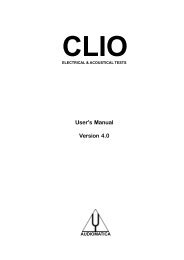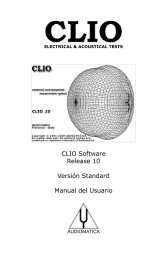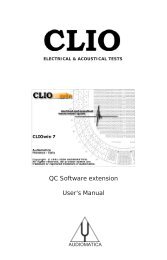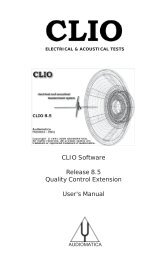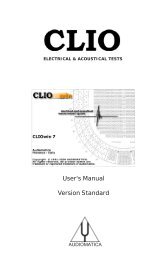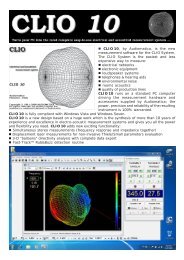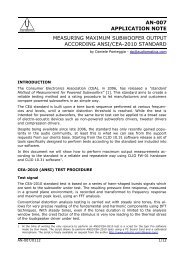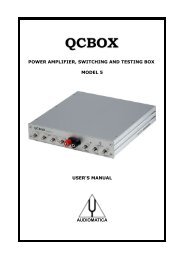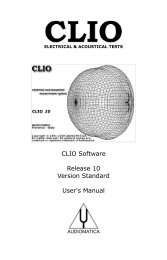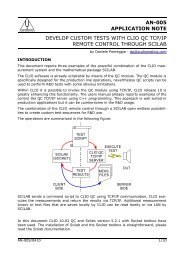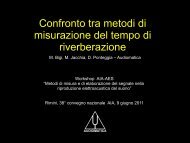Automated Loudspeaker Balloon Measurement - Audiomatica Srl
Automated Loudspeaker Balloon Measurement - Audiomatica Srl
Automated Loudspeaker Balloon Measurement - Audiomatica Srl
You also want an ePaper? Increase the reach of your titles
YUMPU automatically turns print PDFs into web optimized ePapers that Google loves.
AES San Francisco 2008<br />
Exhibitor Seminar ES11<br />
Saturday, October 4, 1:00 pm — 2:00 pm<br />
<strong>Automated</strong><br />
<strong>Loudspeaker</strong> <strong>Balloon</strong><br />
Response <strong>Measurement</strong><br />
<strong>Audiomatica</strong> SRL
3D Polar <strong>Measurement</strong>s<br />
• In this seminar we will analyze the whys and the how of<br />
loudspeaker polar measurements<br />
• Every aspect of the measurement process will be<br />
treated in detail (but in fact more questions than<br />
answers will be raised...)<br />
• The CLIO + Outline ET250-3D automatic measurement<br />
process will be showed<br />
• Exportation of sets of polar data to most used<br />
simulation softwares formats will be showed<br />
2<br />
3D Polar <strong>Measurement</strong>s<br />
M. Bigi, D. Ponteggia - <strong>Audiomatica</strong>
Polar <strong>Measurement</strong>s Aim<br />
• Polar measurement sets are used for<br />
(contexts):<br />
– Laboratory use:<br />
• design and validation<br />
• input for design simulation softwares<br />
• technical documentation<br />
– Public use:<br />
• data sheets and catalogs<br />
• technical publications<br />
• models for commercial simulation softwares<br />
(EASE, CLF, ...)<br />
3<br />
3D Polar <strong>Measurement</strong>s<br />
M. Bigi, D. Ponteggia - <strong>Audiomatica</strong>
<strong>Loudspeaker</strong> Radiation Model<br />
• A loudspeaker source can be seen as a single input<br />
multiple output system and modeled as a point source:<br />
OUT<br />
IN<br />
S<br />
4<br />
with a given transfer function (linear model) for every<br />
point in the surrounding space S. In order to model the<br />
system it is necessary to sample the response into the S<br />
space.<br />
3D Polar <strong>Measurement</strong>s<br />
M. Bigi, D. Ponteggia - <strong>Audiomatica</strong>
Point Source Model<br />
• If the loudspeaker can be modeled as a point source it<br />
is possible to sample the response over a sphere<br />
centered in the source position.<br />
S<br />
5<br />
3D Polar <strong>Measurement</strong>s<br />
M. Bigi, D. Ponteggia - <strong>Audiomatica</strong>
How To Sample?<br />
• How to sample over a sphere?<br />
– Which spherical coordinate system?<br />
– How many “meridians” (aka polars)?<br />
• Use regular sampling or adaptive?<br />
– Which resolution if regular?<br />
– It seems also reasonable to use a finer resolution<br />
where the energy content is high (can be seen also<br />
as a coarse resolution where the energy content is<br />
low, i.e. back emission)<br />
– Spherical harmonics?<br />
6<br />
3D Polar <strong>Measurement</strong>s<br />
M. Bigi, D. Ponteggia - <strong>Audiomatica</strong>
Spherical Coordinate System<br />
Weisstein, Eric W. "Spherical Coordinates." From MathWorld - A Wolfram Web<br />
Resource. http://mathworld.wolfram.com/SphericalCoordinates.html<br />
7<br />
3D Polar <strong>Measurement</strong>s<br />
M. Bigi, D. Ponteggia - <strong>Audiomatica</strong>
Spherical Coordinate System<br />
• We adopt this spherical coordinate system:<br />
y<br />
r<br />
φ<br />
z<br />
θ<br />
x<br />
Is it possible to think at the source pointing its on-axis direction<br />
towards the north pole. In this way the polars (meridians) are<br />
effectively passing thru the poles.<br />
8<br />
3D Polar <strong>Measurement</strong>s<br />
M. Bigi, D. Ponteggia - <strong>Audiomatica</strong>
• Simple and FAST<br />
Simplest Method H+V<br />
y<br />
VERTICAL<br />
HORIZONTAL<br />
z<br />
x<br />
9<br />
3D Polar <strong>Measurement</strong>s<br />
M. Bigi, D. Ponteggia - <strong>Audiomatica</strong>
Simplest Method H+V<br />
• Sample the response over only two polars, the<br />
Horizontal and Vertical polar with a given angular<br />
resolution<br />
– common values for theta (polar angle) resolution are 5<br />
degrees<br />
– phi resolution is 90 degrees<br />
• Then the missing polars are interpolated mathematically<br />
– how to interpolate?<br />
• Elliptical interpolation<br />
• Smoothness of the balloon shape<br />
– Is it the interpolation meaningful?<br />
• Only in very simple cases<br />
• Works only for magnitude data AFAIK<br />
10<br />
3D Polar <strong>Measurement</strong>s<br />
M. Bigi, D. Ponteggia - <strong>Audiomatica</strong>
Why H+V is simple?<br />
• The measurement setup involve a single PC controlled<br />
turntable<br />
– the PC control can be quite basic, just sending pulses<br />
to the turntable<br />
• The loudspeaker can be easily put on the turntable in<br />
vertical and horizontal position and only two polars need<br />
to be sampled<br />
• For a regular sampling angle of 5 degrees only 144<br />
points are needed, the procedure can be completed in<br />
less than 10 mins<br />
11<br />
3D Polar <strong>Measurement</strong>s<br />
M. Bigi, D. Ponteggia - <strong>Audiomatica</strong>
Adding Complexity<br />
• If we want to collect other<br />
polars, a single turntable is not<br />
sufficient : we need to rotate<br />
the loudspeaker over another<br />
axis<br />
y<br />
• In fact this is exactly what we<br />
do with the H+V by placing the<br />
loudspeaker on the turntable in<br />
two positions<br />
polar<br />
azimuth<br />
• The second rotation axis<br />
can be realized using a second<br />
turntable or manually rotating<br />
the device<br />
z<br />
x<br />
12<br />
3D Polar <strong>Measurement</strong>s<br />
M. Bigi, D. Ponteggia - <strong>Audiomatica</strong>
Big Setup Example<br />
13<br />
3D Polar <strong>Measurement</strong>s<br />
M. Bigi, D. Ponteggia - <strong>Audiomatica</strong>
Small Setup Example<br />
14<br />
3D Polar <strong>Measurement</strong>s<br />
M. Bigi, D. Ponteggia - <strong>Audiomatica</strong>
Full 3D - different approaches<br />
• There are some different approaches that we need to<br />
mention apart from our 2 turntables setup:<br />
– Arc of microphones and multichannel data acquisition<br />
• very fast<br />
• complex<br />
• needs an anechoic chamber<br />
• fixed angular resolution<br />
– Rotating microphone<br />
• not faster<br />
• bit complex to get working in non-anechoic spaces<br />
• mechanical oscillations of the long microphone boom arm<br />
15<br />
3D Polar <strong>Measurement</strong>s<br />
M. Bigi, D. Ponteggia - <strong>Audiomatica</strong>
How Complex do we get?<br />
• With two axis of rotation is it possible to sample the<br />
loudspeaker response at every point of the surrounding<br />
spherical surface<br />
• Regularly sampling over polars leave us the possibility<br />
to choose two different resolutions for the theta and phi<br />
angles<br />
– as an example it is possibile to sample theta at 5 degrees<br />
and phi at 30 degrees<br />
– is it better to choose the same resolution for the theta and<br />
phi angles?<br />
– The AES standard currently under discussion recommends<br />
a 5 degree resolution for both angles<br />
16<br />
3D Polar <strong>Measurement</strong>s<br />
M. Bigi, D. Ponteggia - <strong>Audiomatica</strong>
Interpolation, again?<br />
• At this point it must be noted that some degree of<br />
interpolation must be carried out at a certain point of<br />
the modeling process.<br />
• If the response of the source is known over a given<br />
number of point over the space:<br />
– from the point of view of the measurement process we need to<br />
decide which is the correct angular sampling angle<br />
– it is possible here to follow the recommendations and use a 5<br />
degree angle and leave the interpolation issue to the users of the<br />
measured data (simulation softwares)<br />
– It has been showed by Ahnert and Feistel that the angular<br />
resolution is related to the simulation accuracy, and that given a<br />
resolution the simulation error is bounded below a certain<br />
frequency (The Significance of Phase Data for the Acoustic<br />
Prediction of Combinations of Sound Sources, AES preprint no.<br />
6632)<br />
17<br />
3D Polar <strong>Measurement</strong>s<br />
M. Bigi, D. Ponteggia - <strong>Audiomatica</strong>
Full 3D<br />
• Complex and SLOW<br />
y<br />
x<br />
z<br />
in the worst case (no symmetry) at 5 degree resolution<br />
2664 impulse responses needs to be measured<br />
18<br />
3D Polar <strong>Measurement</strong>s<br />
M. Bigi, D. Ponteggia - <strong>Audiomatica</strong>
Practical considerations<br />
• At this point we are quite confident on the fact that<br />
“high resolution” polar measurements must be carried<br />
out in 3D with a resolution of 5 degrees...<br />
• There is still a couple of practical problems to take into<br />
account before starting to make measurements:<br />
– Distance source-to-microphone<br />
– Anechoic or non-anechoic space (closely related to the<br />
distance)?<br />
19<br />
3D Polar <strong>Measurement</strong>s<br />
M. Bigi, D. Ponteggia - <strong>Audiomatica</strong>
Source to Microphone distance<br />
• It is known that the distance must be sufficiently high to<br />
measure the far field response. Commonly used<br />
distance for arrayable loudspeaker ranges from 4 to 8<br />
meters.<br />
• A greater distance reduce also the error related to apex,<br />
due to the fact that we model the source as a point and<br />
that we rotate the source around another point that can<br />
be non coincident with the “acoustical center”<br />
• This can lead to measuring distances as high as 6-8<br />
meters.<br />
20<br />
3D Polar <strong>Measurement</strong>s<br />
M. Bigi, D. Ponteggia - <strong>Audiomatica</strong>
Anechoic or not?<br />
• In theory a big anechoic room is the solution.<br />
But it is difficult to get distances greater than 4m in<br />
common sized anechoic chambers<br />
• Also the measurement setup can be quite heavy and<br />
need to be very stable, which is hard to achieve over a<br />
cable floor<br />
• A solution can be the use of semi-anechoic chambers or<br />
low reverberation spaces (large spaces with sufficiently<br />
low reverberation)<br />
• A non-anechoic or semi-anechoic chamber can cut the<br />
costs dramatically<br />
21<br />
3D Polar <strong>Measurement</strong>s<br />
M. Bigi, D. Ponteggia - <strong>Audiomatica</strong>
Please, , NO Outdoors!<br />
• The temptation to perform 3D polar measurements<br />
outdoors is high, but the uncontrolled environment<br />
together with long duration of the measurement process<br />
can lead to big errors!<br />
• Discarding the effect of the wind and the noise, a<br />
change in temperature will cause a phase shift:<br />
distance 6m<br />
frequency 10kHz<br />
22<br />
3D Polar <strong>Measurement</strong>s<br />
M. Bigi, D. Ponteggia - <strong>Audiomatica</strong>
Not or Semi-Anechoic<br />
• There are two issues to take into account.<br />
– Reflections (can be eliminated by impulse windowing)<br />
– Reverberation (can cause time alias between different<br />
measurements)<br />
23<br />
3D Polar <strong>Measurement</strong>s<br />
M. Bigi, D. Ponteggia - <strong>Audiomatica</strong>
Managing Reflections<br />
• Is it possible to use time windowing to get rid of the<br />
room reflections<br />
– The IR must be reflection free for at least T=1/f, where f is<br />
the lowest frequency we want to measure<br />
– In order to get this the source must be sufficiently far<br />
away from reflective boundaries, or the boundaries must<br />
be treated (in the frequency range) to be absorpting.<br />
• C.Struck, S.Temme, “Simulated Free Field<br />
<strong>Measurement</strong>s”, JAES, Vol. 42, No. 6, 1994 June.<br />
24<br />
3D Polar <strong>Measurement</strong>s<br />
M. Bigi, D. Ponteggia - <strong>Audiomatica</strong>
25<br />
Room Reflections<br />
ceiling<br />
reflection<br />
R<br />
S<br />
direct path source wall<br />
receiver wall<br />
reflection<br />
lateral<br />
reflection<br />
reflection<br />
h<br />
floor<br />
reflection<br />
W<br />
d r<br />
d<br />
D<br />
3D Polar <strong>Measurement</strong>s<br />
M. Bigi, D. Ponteggia - <strong>Audiomatica</strong><br />
H<br />
d s<br />
Given the minimum frequency to be<br />
measured it is possible to calculate<br />
the needed room dimensions
Room Reflections<br />
0.20<br />
Pa<br />
<strong>Audiomatica</strong> <strong>Srl</strong> LogChirp - Impulse Response 9-20-2008 12.59.27 PM<br />
DIRECT SOUND<br />
CLIO<br />
0.12<br />
REFLECTION<br />
0.040<br />
-0.040<br />
-0.12<br />
-0.20<br />
0 2.5 4.9 7.4 9.9 12 15 17 20 ms 22 25<br />
CH A dBSPL Unsmoothed 48kHz 4K Rectangular Start 0.00ms Stop 8.63ms FreqLO 115.94Hz Length 8.62ms<br />
File: hidriver 0 0.mls<br />
26<br />
3D Polar <strong>Measurement</strong>s<br />
M. Bigi, D. Ponteggia - <strong>Audiomatica</strong>
Managing Reverberation<br />
• The reverberation time can cause time aliasing between<br />
measurement<br />
• There is the need to let the energy decay sufficiently<br />
before taking another measurement<br />
• The RT60 must be low at least for the frequency range<br />
we are measuring<br />
• An anechoic chamber is the perfect choice, but a so<br />
called “low reverberation chamber” can work good also<br />
27<br />
3D Polar <strong>Measurement</strong>s<br />
M. Bigi, D. Ponteggia - <strong>Audiomatica</strong>
CLIO and 3D<br />
• CLIO can control two turntables and automatically<br />
perform a set of 3D measurements<br />
• What’s new?<br />
– turntable control dialog*<br />
– 3D autosave procedure*<br />
– 3D analysis menu**<br />
– data export in various ASCII formats**<br />
• New turntables commercially available:<br />
– Outline ET250-3D<br />
– LinearX LT360<br />
*in production **beta<br />
28<br />
3D Polar <strong>Measurement</strong>s<br />
M. Bigi, D. Ponteggia - <strong>Audiomatica</strong>
The new Outline ET250-3D<br />
turntable<br />
• Outline recently released the new ET250-3D turntable:<br />
29<br />
3D Polar <strong>Measurement</strong>s<br />
M. Bigi, D. Ponteggia - <strong>Audiomatica</strong>
Turntables Dialog<br />
• With this dialog it is possible to<br />
connect and send commands to<br />
the turntables<br />
• Start, stop and resume an<br />
autosave procedure<br />
30<br />
3D Polar <strong>Measurement</strong>s<br />
M. Bigi, D. Ponteggia - <strong>Audiomatica</strong>
Turntables Options<br />
• Specify which turntables is<br />
used for the polar (1) and<br />
azimuth (2) axis and<br />
communication setup<br />
• Turntable 2 choice:<br />
– Outline ET250-3D<br />
– LinearX LT360<br />
– Manual<br />
• Turntable 1 choice:<br />
– Outline ET250-3D<br />
– LinearX LT360<br />
– TTL Pulse (legacy<br />
mode*)<br />
*If a parallel port is not present on the PC it is possible to use the CLIO QC BOX model V to<br />
generate the pulses (i.e. how to drive an old Outline ET2 without a parallel port)<br />
31<br />
3D Polar <strong>Measurement</strong>s<br />
M. Bigi, D. Ponteggia - <strong>Audiomatica</strong>
New CLIO Autosave<br />
• Two autosave methods are available:<br />
– 1D: Basically the old CLIO method, to be used as a legacy<br />
mode<br />
– 3D: Can perform either single polar or full sphere<br />
measurements using two turntables<br />
32<br />
3D Polar <strong>Measurement</strong>s<br />
M. Bigi, D. Ponteggia - <strong>Audiomatica</strong>
New CLIO Autosave<br />
y<br />
r<br />
z<br />
x<br />
.mls<br />
33<br />
3D Polar <strong>Measurement</strong>s<br />
M. Bigi, D. Ponteggia - <strong>Audiomatica</strong>
New CLIO Autosave<br />
• Polar and Azimuth angular resolution is independent<br />
– Example only horizontal and vertical polar with 5 degree<br />
resolution:<br />
• phi resolution = 90<br />
• theta resolution = 5<br />
– Example polar every 15 degrees and 5 degrees<br />
resolution:<br />
• phi resolution = 15<br />
• theta resolution = 5 degrees<br />
• The SmartScan algorithm reduces polar data set<br />
measurement time and avoid cabling problems<br />
scanning the polar angle back and forth<br />
34<br />
3D Polar <strong>Measurement</strong>s<br />
M. Bigi, D. Ponteggia - <strong>Audiomatica</strong>
CLIO Automation<br />
• Once the turntables are connected, and the autosave<br />
setup is done… just press GO!<br />
• CLIO will take care of controlling the turntables, getting<br />
the measurements, saving the files with the naming<br />
scheme.<br />
• It is also possible to halt the measurment process and<br />
to resume it in a later time<br />
35<br />
3D Polar <strong>Measurement</strong>s<br />
M. Bigi, D. Ponteggia - <strong>Audiomatica</strong>
Before to GO!<br />
• To avoid the unwanted reflections it is necessary to<br />
setup the time windowing, this can be done doing an<br />
mls measurement on-axis and carefully setting the stop<br />
window.<br />
• In theory it is possible to apply this windowing after<br />
collecting the measurement set, but to avoid to<br />
reprocess during the analysis a great number of<br />
responses the windowing has to be done in advance.<br />
• It is also necessary that the disk where we want to save<br />
the measurements has a sufficient disk space...<br />
36<br />
3D Polar <strong>Measurement</strong>s<br />
M. Bigi, D. Ponteggia - <strong>Audiomatica</strong>
Data Set Size<br />
• The Data Set size depends on the MLS size and the<br />
number of measurements to be performed:<br />
37<br />
3D Polar <strong>Measurement</strong>s<br />
M. Bigi, D. Ponteggia - <strong>Audiomatica</strong>
Press GO! …and…<br />
Wait...<br />
• The measurement time depends on many factors. Here<br />
is reported an example using two Outline turntables:<br />
38<br />
3D Polar <strong>Measurement</strong>s<br />
M. Bigi, D. Ponteggia - <strong>Audiomatica</strong>
3D Analysis<br />
• This is a beta version of the upgraded Waterfall and<br />
Directivity module, basically it is a tool to check that the<br />
3D measurements has let to meaningful results<br />
• An enhanced version with better graphics support is<br />
already on the wish-list, at the moment it is a basic<br />
wireframe view of the magnitude balloon with controls<br />
to rotate the balloon and to zoom in and out the balloon<br />
range (inflate/deflate?)<br />
39<br />
3D Polar <strong>Measurement</strong>s<br />
M. Bigi, D. Ponteggia - <strong>Audiomatica</strong>
3D Analysis<br />
40<br />
3D Polar <strong>Measurement</strong>s<br />
M. Bigi, D. Ponteggia - <strong>Audiomatica</strong>
Export Data<br />
• There are some ways to use the measured data sets,<br />
some implemented into the 3D Analysis menu:<br />
– Export to a single .xhn EASE (only magnitude) *<br />
– Export to a single CLF v2 .tab *<br />
– Export a single responses as time data .txt (to be imported<br />
with EASE SpeakerLab)<br />
• It is also possible to import the data sets into Matlab or<br />
Scilab where the processing and visualization options<br />
are countless<br />
* regular sampling of 5 degrees for both phi and theta angle<br />
is needed<br />
41<br />
3D Polar <strong>Measurement</strong>s<br />
M. Bigi, D. Ponteggia - <strong>Audiomatica</strong>
MATLAB (or Scilab)<br />
• Here is an example of a 3D data set measured with<br />
CLIO and visualized using MATLAB<br />
42<br />
3D Polar <strong>Measurement</strong>s<br />
M. Bigi, D. Ponteggia - <strong>Audiomatica</strong>
Import with EASE SpeakerLab<br />
• EASE SpeakerLab can import CLIO time data in .txt<br />
format, the CLIO export routine formats the file with the<br />
name requested by the SpeakerLab.<br />
43<br />
3D Polar <strong>Measurement</strong>s<br />
M. Bigi, D. Ponteggia - <strong>Audiomatica</strong>
Conclusions<br />
• CLIO + 2 x Outline ET250-3D can automatically<br />
measure the loudspeaker 3D polar response<br />
• The setup is very easy to manage, and measurements<br />
can be carried out in non-anechoic spaces<br />
• From a single measured data set it is possible to create<br />
EASE and CLF models, technical documentation and<br />
polar plots<br />
44<br />
3D Polar <strong>Measurement</strong>s<br />
M. Bigi, D. Ponteggia - <strong>Audiomatica</strong>
Thank you!<br />
For more info:<br />
info@audiomatica.com<br />
www.audiomatica.com



